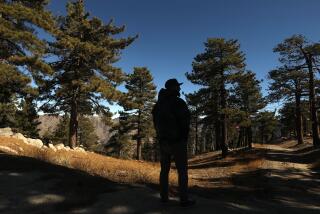Perris in Springtime: Isn’t It Just Romantic?
- Share via
Looking for romance? Try Perris in the springtime.
No need to battle the hordes of tourists flocking to that similar-sounding place across the Atlantic. No need to travel 6,000 miles and spend lots of your hard-earned francs to have a good time.
For a mere 30-franc ($5) admission fee, you can visit a man-made wonder, Lac de Paris, otherwise known as Lake Perris State Recreation Area. So pack du pain et du vin and head for the most romantic Pomona Freeway off-ramp in all of Southern California.
Few nature lovers--or lovers of any kind--have discovered the romance of Perris. True, 1.5-million visitors come to the lake each year, but the only nature most are interested in is that found wriggling on the end of a hook.
While the park is oriented to boats and automobiles, there is a network of trails for those visitors who wish to explore Perris a pied. Perris pace-setters will enjoy the trek to Terri Peak, easily the most romantic spot in all of the Bernasconi Hills.
Springtime colors the hills with a host of wildflowers, including goldfields, California poppy, fiddleneck, baby blue eyes and blue decks. The view from Terri Peak on smog-free days is tres fantastique .
Directions to trailhead: From the Pomona Freeway (California 60) a few miles east of its intersection with Interstate 215, exit on Moreno Beach Drive and proceed south 4 miles to the park. Immediately after paying your state-park day-use fee at the entry kiosk, turn right on Lake Perris Drive. Look sharply right for the strange-looking international symbol indicating a campfire and an amphitheater. Park in the camp fire/Interpretive Center lot. The unsigned trail begins to the left of the campfire area.
The hike: The trail ascends gradually west and occasionally intersects a horse trail. The unsigned path is tentative at first but an occasional wooden post helps keep you on the trail, which climbs boulder-strewn slopes.
The coastal scrub community--sage, buckwheat, chamiso and toyon--predominates. Also much in evidence are weedy-looking non-native species, as well as mustard, prickly-pear cactus, morning glory and Russian thistle.
The trail climbs to a small, flat meadow, then turns southwest and climbs more earnestly to the peak. From atop Terri Peak, enjoy clear-day views of the San Bernardino Mountains to the northeast and the Santa Ana Mountains to the southwest. Below is fast-growing Moreno Valley, checkerboarded alternately with green fields and subdivisions. You can see all of Lake Perris, Alessandro Island and thousands of boaters, anglers and swimmers.
The trail from Terri Peak down to the Indian Museum is in poor condition. Beginning hikers may want to retrace their steps to the trailhead. The more experienced will begin their descent. Expect to lose the trail a couple of times; however, you won’t get lost because it’s easy to stay oriented with the lake shore on your left and the Indian Museum ahead.
After a steep descent, the trail bends sharply east and deposits you at the Indian Museum parking lot. The museum includes exhibits interpreting the Cahuilla, Chemehuevi Luiseno, Serrano and other desert tribes and how they adapted to life in the Mojave Desert region.
From the museum, you follow the asphalt road down to Lake Perris Drive, cross this main park road and continue down to Perris Beach. Here, and at Moreno Beach one mile to the west, you may cool off with a swim.
Improvise a route along the lake shore using the sidewalk and bicycle trail until you spot the main campground entrance on your left. Enter the campground, pass the kiosk, then pick up the intermittent footpath that winds through the campground. This path and some improvisation will bring you to Lake Perris Drive and back to the trailhead.
Terri Peak Trail
Interpretive Center to Terri Peak: 3 1/2 miles round trip.
800-foot elevation gain
Interpretive Center to Indian Museum, return via lake shore: 6 miles round trip
More to Read
Sign up for The Wild
We’ll help you find the best places to hike, bike and run, as well as the perfect silent spots for meditation and yoga.
You may occasionally receive promotional content from the Los Angeles Times.






